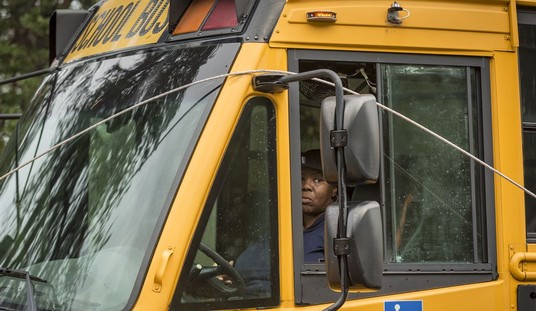The media establishment has made it a never-ending series: features on the political views of public figures who just happen to be far-Leftists. The latest ran in the Independent on Wednesday: musician Bruce Hornsby, author of the deathless eighties classic “The Way It Is,” reminiscences about growing up in the “deeply conservative” town of Williamsburg, Virginia, where, he says, the kids in his third-grade class cheered when they heard that JFK had been assassinated. It’s a jarring story, but it reveals more about the Left’s false historical narrative – particularly regarding the fabled “switch” of the Democratic and Republican parties over civil rights – than it does about Williamsburg or the South in the sixties.
There are numerous oddities in Hornsby’s recollections, suggesting that the aging boomer’s memories may be filtered at this late date through the prism of the Leftist narrative. For instance, he says that when Kennedy’s death was announced at his school, “almost my entire class cheered. They were shouting: ‘Hurray! Now Nixon can take over!’ But I was so shocked. I felt awful. It was a seminal moment in my childhood, just stamped on my brain and I still get chills when I think about it.”
What little monsters. But of course they were only reflecting attitudes they had imbibed at home. “Narrow-minded attitudes prevailed in my small southern town,” Hornsby explains. “But my mum, Lois, was from a more forward-thinking family of New Englanders who’d moved down to Richmond when her dad got a job there as a church organist. Liberal Lois, my mum, married a big old handsome country boy. Bob Hornsby was from a fishing village and he was cut from the local cloth. My parents’ votes cancelled each other out in elections from 1948 to 1976 when my mum persuaded my dad to vote for Jimmy Carter and he never looked back and he voted Democrat for the rest of his life.”
Well, maybe it happened exactly that way. But maybe it didn’t. Hornsby’s story is odd in numerous ways. First off, third-graders can be forgiven for not knowing that Vice President Lyndon Johnson, not the candidate Kennedy defeated in the 1960 election, Richard Nixon, would become president on JFK’s death, but that is not the only strange aspect of Hornsby’s story.
The Independent and Hornsby would have us believe that these children loved Nixon and hated Kennedy because Williamsburg was a “deeply conservative” town. In one sense that is true: Williamsburg gave Nixon 59% of the vote in 1960. And maybe the 40% of the town that went for Kennedy had so few children that they made up a far smaller percentage of Hornsby’s third-grade class.
However, while Virginia as a whole went for Nixon, Virginia is the upper South, which historically has been less “deeply conservative” than the Deep South. Hornsby might be surprised to learn that states that in 1960 were much more ardently segregationist than Virginia voted for Kennedy, including North Carolina, South Carolina, Georgia, Louisiana, Arkansas, and Texas.
What’s more, as Rating America’s Presidents: An America-First Look at Who Is Best, Who Is Overrated, and Who Was An Absolute Disaster explains, Nixon and Kennedy were running to succeed the Republican Dwight D. Eisenhower, who had a “forward-thinking” stance on civil rights, and was bitterly opposed by segregationist Southerners who were all Democrats. When Eisenhower’s Secretary of the Navy Robert Anderson advised the president not to press the South to accept the integration of the armed forces, the president shot back: “We have not taken and we shall not take a single backward step. There must be no second-class citizens in this country.”
Eisenhower signed the Civil Rights Acts of 1957 and 1960, which encountered firm resistance in the solidly Democratic South. After the Supreme Court ruled in Brown v. Board of Education of Topeka that segregation in schools was unconstitutional, Eisenhower sent the National Guard to Arkansas to make sure that segregationist Democrat Governor Orval Faubus would not be able to block the entry of black students into a public high school in Little Rock.
Yet Hornsby portrays his pro-Nixon town of the early 1960s as a bastion of conservative opposition to what was “forward-thinking.” Hornsby and his English interviewer appear to assume that the segregationists were Republicans and the “forward-thinking” folks were Democrats, reflecting the demonization of the Republican Party and conservatives that has been going on for decades now.
More commonly, we hear that while the Republican Party started out in favor of civil rights, it switched places with the Democrats in the 1960s when the Civil Rights Act of 1964 became law, so as to gain disenchanted segregationist ex-Democrat voters. This “party switch” idea is taken as axiomatic today among America’s miseducated youth, but in reality, there is nothing to it. Rating America’s Presidents shows that Republicans in both the House and Senate voted for the Civil Rights Act of 1964 in higher percentages than did Democrats. The growing Republican support in the South in the 1960s and thereafter is frequently attributed to the supposed racism of the party, but in reality, segregation and Jim Crow ended at the same time that Republican support was growing, and no Republicans campaigned on bringing them back. The “Southern strategy” was not a Republican embrace of racism, but of social conservatism and greater economic freedom than the Democrats offered, both of which had great appeal in the South.
Bruce Hornsby is, of course, just a piano player, not a historian or a political analyst. Thus it isn’t all that surprising that his dubious narrative of his Virginia youth reflects prevailing historical myths about America’s political parties and general culture. For decades now, the myth of the “party switch” has been an integral part of the false narrative that has bamboozled far too many people into thinking that the Democratic Party was on the side of justice and equality of rights for all people. But whether or not Bruce Hornsby starts to regain clearer recollections of his early childhood, those days may be coming to an end.
Robert Spencer is the director of Jihad Watch and a Shillman Fellow at the David Horowitz Freedom Center. He is author of 21 books, including the New York Times bestsellers The Politically Incorrect Guide to Islam (and the Crusades) and The Truth About Muhammad. His latest book is Rating America’s Presidents: An America-First Look at Who Is Best, Who Is Overrated, and Who Was An Absolute Disaster. Follow him on Twitter here. Like him on Facebook here.










Join the conversation as a VIP Member